THE NEXT HERCULES: THE ATT?
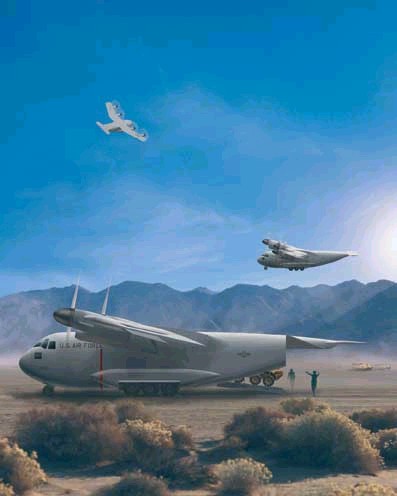

Super C-130 Aviation expert, pilot, historian Sam McGowanSamC130@aol.com writes:
"XXXXX just sent me a brochure advertizing Boeing's concept of an Advanced Theater Transport (ATT). Guess what - it has no tail! For those who have never seen an artist's concept, the Boeing ATT is a wide-body four-engine turboprop aircraft with only one plane - a tiltable wing attached to the midpoint of the fuselage.
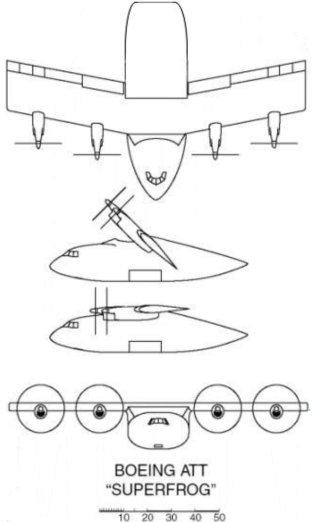
The overall dimensions of the aircraft are less than that of a C-130, though the wider fuselage - which evidently is also a lift-producing device - allows larger payloads. Boeing is advertizing 11 standard 463L pallets with 40 troops seated on the side, for a total payload of 100,000 pounds. They claim it will be able to operate into airstrips as short as 600 feet, thanks to the tilt-wing technology. The props are linked together (though just what this is supposed to accomplish in the event of an engine failure is beyond me. Loss of power is loss of power. The only advantage to linked propellers is that there is no 'critical' engine.)
Now, such a concept definitely has applications for the future battlefield, though I have my doubts about its use in close proximity to enemy positions. Even though the Boeing ATT is an airplane, it will function very much like a helicopter while it is based on a complex system that increases the likelihood of damage from ground fire and/or increased maintenance. In their brochure, Boeing does not make a proper comparison between their ATT and the C-130J.
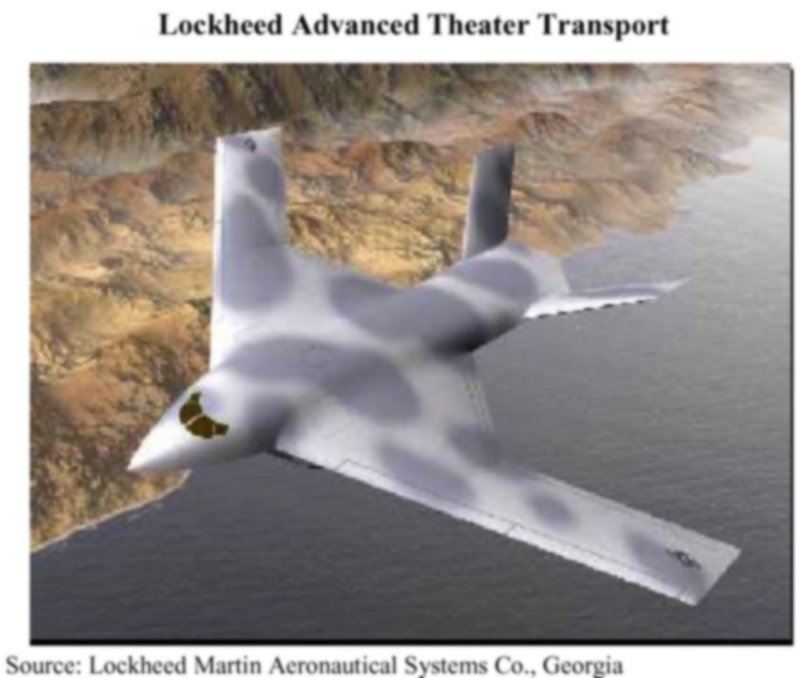
They use a 3,500 foot runway length for the C-130 without taking into consideration that this is FAR Part 25 runway requirements, not a military requirement. A chart shows that the ATT could land on 120 landing sites in the state of South Dakota while only two are useable by C-130s. While this may be true of existing runways in the state (using 3,500 feet as a minimum,) it does not take into consideration the C-130's off runway capabilities. Nor does it take into consideration that the minimum runway for a C-130 in the Vietnam War was 2,500 feet, and that included an extra 500 feet to allow a margin for error.
Assuming the design will live up to expectations - and few designs do - and the price is reasonable (Come on, we are talking about the modern defense industry!) I can see where the concept might be valid."
Sadly, Sam's message was from 2000, over 7 years ago!
That the USAF is not interested in airlifters that can land in the dirt or get wet is quite apparent. Now under pressure to deliver supplies so they can avoid being trucked and blown up by enemy land mines along roads, they suddenly want a crash program for a less-than-1, 000 foot runway cargo plane. About 60 years late. Don't forget Burt Rutan delivering a STOL cargo planes as DoD requested that was ignored...along with his Ares "mudfighter" CAS plane. The USAF could be playing with a land-in-the-dirt transport plane yet again....Legendary aviation expert, Bill Sweetman writes:
http://aviationweek.typepad.com/ares/2007/04/auroras_take_on.html
April 24, 2007Aurora's Take on the ACCA
Build a cargo-carrying X-plane in 18 months. That's the broad-brush goal of the Advanced Composite Cargo Aircraft (ACCA) project, kicked off last Friday by the Air Force Research Laboratory. The AFRL awarded two contracts worth a potential $47 million each, one (unsurprisingly) to Lockheed Martin - questions were referred to the company's Skunk Works in Palmdale, California - and the other, much more surprisingly, to Aurora Flight Sciences. Until now, Aurora has specialized in unmanned air vehicles, most of them small. Aurora president John Langford says that more details of the company's design may be forthcoming in a couple of weeks. He tells DTI that the program's objective is to harvest new technologies in rapid prototyping, composites and flight control in order to build a near-full-size prototype of a cargo airplane - smaller than a C-130 and closer in size to the EADS-CASA C-295 and Alenia C-27J, the contenders in the Army-USAF Joint Cargo Aircraft project - which can use very short, austere runways.
ACCA would be Aurora's first manned aircraft, though Langford makes it clear that the company is looking at concepts that could have "a two-person crew, a one-person crew or no crew". Carrying cargo with an unmanned aircraft could potentially reduce costs and avoid the risk of a crew being captured on hazardous missions.
The project represents a school of thought in airlifter design that maintains that an airplane that can use a very short runway - 750-1,000 feet, for example, well under half what a JCA-type aircraft needs - may be almost as useful as a vertical take-off design, but would be less complex and cheaper. That was the objective of Boeing's tailless, tilt-wing Super Frog study of the mid-1990s and of Burt Rutan's DARPA-funded Advanced Technology Tactical Transport, a twin-boom prototype for a special-operations aircraft.
Phase 1 of the ACCA project, the design of the prototype, is due to be complete by the end of FY2007. Under Phase 2, the prototype itself should fly by late 2008. The USAF has not yet told the contractors whether it intends to fund both designs through Phase 2.
NEW TACTICAL AIRLIFTER OVER-VIEW
The best over-view of the USAF's future airlifter to replace the C-130 Hercules fleet as it retires is Colonel Harry Shine's Theater Airlift 2010 paper:
In it, he asks if a "technological breakthrough" could enable an aircraft to lift large loads V/STOL without resorting to a tilt-rotor on "steroids". This would be a "stealthy" compound heavy-lift helicopter to replace the CH-47D/F Chinook: a CH-53X or "MH-2000X"

This would enable the U.S. Army to move all its equipment quickly and undetected forward into enemy lines up to light/medium armored fighting vehicles using Air Assault techniques. The MH-2000X would self-deploy itself across oceans eliminating the need for USAF airlifters to fly them to the battlefield via contested airfields.
"Since the Airborne and Light infantry forces heavily depend on helicopters for tactical mobility and firepower, the Airborne will continue to be tied to airfields until modernized. Airdroppable tactical mobility and firepower are needed to wean the Airborne forces from their absolute dependence on airfields."
Major Michael Kazmierski, USCGS Master's Thesis
Cactus Air Force Sort Of....
One of the downfalls of American "air power" is its refusal after the 1947 U.S. Air Force separation from the U.S. Army to develop the technologies to operate fixed-wing aircraft from unimproved ground---Army Lieutenant General Gavin's "cow pasture" aircraft. Extreme Short Take-Off and Landing (ESTOL) technologies like tracked and air cushion landing gear and eventually vertical take-off and landing (VTOL) capabilities would enable nearly any flat open area to become a take-off and landing strip for observation/attack and transport planes. However, without this technological push, aircraft are stuck in the rolling tire landing gear "rut"--pun intended. If expedient surfaces are smoothed and not secured by aluminum matting or Rhino Snot sealant ruts can form that when an aircraft rolls into them rips off its landing gear. The photo below of Landing Zone "N" in Normandy on D-Day, June 6, 1944 showing many British gliders on it reveals the kind of grassy fields Gavin wanted his Airborne forces to be able to land into and take-off from that was once possible with gliders but no longer today.
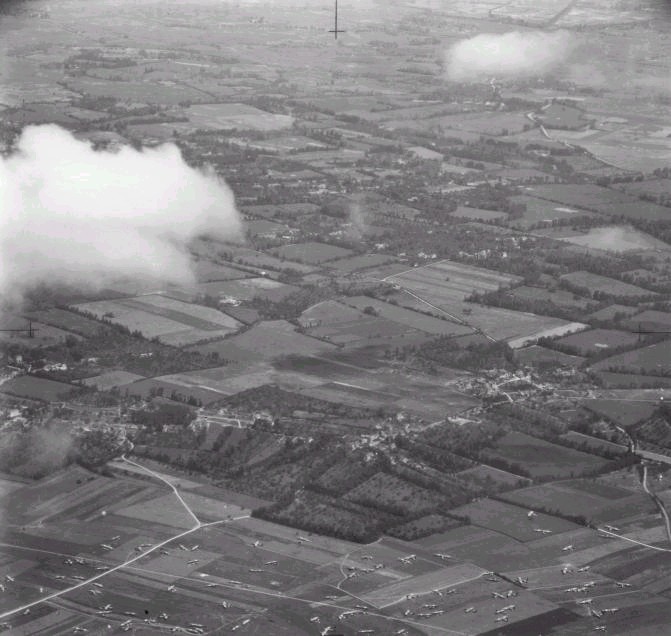
Static Forward Air Base Security Math: Poor Force Structure Quality cannot be Saved by Quantity
Stuck--pun intended---with wheeled landing gear, aircraft have been restricted to how little of this smooth runway they can live with by their SIZE which drives runway thickness/hardness and their required run LENGTH to create lift. The length of the runway then drives the force size needed to guard it by area formula which translates into basically 6x its length. If a runway is 10, 000 feet long, at the bare minimum it needs 60, 000 feet of perimeter defended just to keep enemies off the runway from cratering it or placing obstacles on it. Generally, effective small-arms fire range is 300 meters or 1, 000 feet so to keep small caliber 7.62mm bullets out, the perimeter needs to grow in all directions by 2, 000 feet because you need stand-off from the front and back ends of the runway. So a 10, 000 foot runway requires 72, 000 feet of perimeter to keep small arms fire away. Most small man-portable air defense systems military jargon for shoulder-fired surface-to-air missiles (SAMs) have 2.5 mile or 13, 200 foot range. To keep MANPADS away, the air base needs from its 10, 000 foot ends another 13, 200 feet added for a total length of 36, 400 feet which multiplied by 6x equals a perimeter of 218, 400 feet or 41.36 miles. To protect a minimum sized air base with a 10, 000 foot runway from direct fire weapons (small arms fire up to heavy machine guns and MANPADS) requires an infantry force of 41 companies!
www.globalsecurity.org/military/library/policy/army/accp/in0754/ch1.htm
IN 0754 PREPARE AND PLAN AN INFANTRY COMPANY DEFENSE
"Units will occupy defensive frontage approximately one-third of that occupied in open areas. An infantry company, which might occupy 1,500 to 2,000 meters in open terrain, will likely be restricted to a frontage of 300 to 800 meters in urban terrain, depending on the density of buildings and rubble, and the street patterns."
This translates to 10+ battalions or 3+ brigades or 1 division of 10, 000 men just to defend the air base---somewhat. This doesn't defend the air base from long range mortar and artillery fires of 7 kilometers and 30 kilometers from decisively shutting down the runway and the French para's supplies as Giap's VietMinh did to Dien Bien Phu in 1954 with hidden 105mm howitzers and 20mm anti-aircraft guns. To create a "recon & security" perimeter to keep enemy mortars and artillery out of range of incinerating exposed aircraft laden with fuel, weapons and troops requires an R&S perimeter of 120 kilometers or 378 kilometers requiring 80 to 252 infantry companies or 2 or 6.3 divisions of 20, 000 to 63, 000 men! However to do static air base security right, one needs the INNER perimeter of 1 division to keep out any "leakers" who get by the OUTER R&S mortar/artillery perimeter of 2 to 6.3 divisions. Thus, to keep one single air base like DaNang or Tan Son Nhut safe in 1965 from Viet Cong direct fire and direct high explosive emplacement "sapper" attacks would require 1/3rd of the entire USMC to rotate in for 1 year or 1/20th of the U.S. Army. To actively patrol a R&S perimeter large enough to keep mortars/artillery out would require the entire USMC plus 3 Army divisions (1/7th of the then 20-division U.S. Army) for just one year then having to be completely spelled by Army thereafter at least for a 1 year hiatus with 1/3rd of the active duty U.S. Army. In 3 years of guarding such an Gavin-style enclave, the entire U.S. Army would have gone to Vietnam, but it might be not so financially costly or lethal to our forces that we could stay there indefinitely to prop up a friendly nation-state government--which we failed to do when we stopped just defending air bases and mission-creeped into career ticket-punching self-validating sweeps for the sub-national and nation-state enemy all across Vietnam. Once we took over fighting from the inept ARVN we began to be financially/casualty bled by the VC/NVA, whose leadership in Hanoi knew we couldn't sustain indefinitely. So if the VC/NVA couldn't instigate a battle defeat like a Dien Bien Phu ("Super Bowl") they would defeat us by making it too costly over time to stay in the "game" ie; we "stop playing football because our knees are shot". One way to defeat "Walter Payton" is have him "retire". War is not just won by duels between armies (battles). Sun Tzu's warning that prolonged wars bring about defeat is not heard by war racketeers who profit from our troops being bled for career officer's to advance by "combat experience".
Had we kept to Gavin's enclave strategy (see his 1968 book, Crisis Now) and refused the enemy battles to bleed us, sallying forth only as needed--say if the NVA tried to cut South Vietnam in two which Moore's 1st Cavalry stopped at LZ X-Ray (but at needless high costs because he didn't have M113 Gavin armored personnel carriers) there is a chance that we would have had American ground forces in position to defeat NVA invasions in 1972 and 1975 in a WW2-style super bowl-type climactic linear battle we somewhat understand. We lost forfeited Vietnam because we couldn't afford to show up because when we were there our "limited war" military incompetence made our presence too costly to maintain.
Better Sub-National Conflict (SNC) Means Begin with Better Aircraft and Tanks
The point here is that we need the qualitative means to prevail in non-linear, sub-national conflicts (SNCs) where civilian life all around, tries to co-exist amongst rebels trying to overthrow the government. First, we must secure the threatened nation's borders with a Morice line type barrier with fencing and sensors patrolled by indigenous troops who we train and equip to a high standard to be an air-mobile cavalry in M113 Gavin type, all-terrain, tracked armored fighting vehicles. Flying overhead are observation/attack fixed wing planes to keep 24/7/365 pressure on any outsiders trying to infiltrate to help the rebels. MacNamara was right about his line on the DMZ to keep the NVA out and unprofessional stupidity of the validate-their-penis-by-gun-battles USMC that refused to build this necessary impediment to infiltration to create a linear separation damned our entire effort in Vietnam. The entire existence of such incompetent egomaniacs as the USMC breeds is counter-productive to the national security of the U.S. and the entire non-adaptive, obsolete outfit should be disbanded. Inside the country, walls and checkpoints manned by indigenous troops would deny warring factions or individual rebels the ability to infiltrate high explosives to car bomb and land mine attack. Americans would have primarily a training/equipping role of the indigenous government workers and have a low-key presence so as to not inflame the locals to rebel against us. We need to create a non-linear battlefield stability corps (NLB-SC) composed of older, more mature adults who have budgets direct from Congress that are ready and equipped and funded to get a nation-state government back on its feet not this "Phase IV" ad hocery that damned us in Iraq. Details:
www.combatreform.org/johnpaulvann.htm
Now we are back full-circle--pun intended---to static air base security driven by our bullshit Air Force's desire to fly too fast and too high with thin-wing fighter-bombers that need long 10, 000 foot runways and to live in comfortable bases with a slice of excessive American consumerism replicated inside sure to infuriate the locals with our excess. By realizing we need slower aircraft to differentiate friend from foe in SNCs, these aircraft can also land on shorter runways or better yet no runways at all, drastically reducing our troop presence on the ground.
The USAF Air Commandos led by legendary genius Brigadier General Heinie Aderholt realized that aircraft slower than 600+ mph jets would be needed just to differentiate "limited war" enemies who try to belt buckle hug American forces on the ground to deny us being able to bring land/sea artillery and air strikes against them as General Ridgway did to them in the Korean war by WW1 style trench lines to create adequate separation. The Air Commando aircraft depicted below show what can be done with slower aircraft and rolling wheel landing gear.
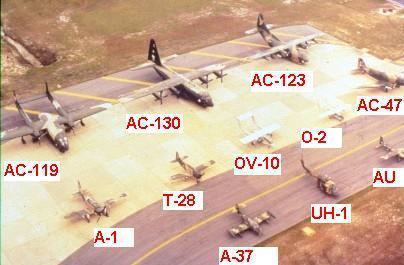
The biggest aircraft depicted, the gunship version of the C-130 simply cannot at 150, 000 pounds plus land on anything less than 3, 000 foot runways, ending up with the Army having to defend a base perimeter of 10 miles against direct-fire weapons, 25 miles against heavy mortars and 62.5 miles to keep long-range 155mm artillery out of range. This still translates into a brigade of Army troops for close-in protection and another 3 or 6 brigades (30, 000 men) for long-range outer protection. With an Army of 30 brigades, one air base defense for one year would require 1/30th or 1/10th or 1/5th of the Army to occupy. "Air Power" using even STOL aircraft is killing the Army by having it maintain its existence through easily ambushed truck resupply convoys or make the taxpayers go broke having to Dien Bien Phu airlift supplies in at a cost of $64, 000/flight hour by C-17. We have more than one such air base in Iraq so that 150, 000 troops are there doing mostly nothing but consume supplies and keep our airplanes safe is costing us $2 BILLION a week--expenses we cannot sustain so we will have to leave the "playing field" because we cannot afford to keep the "stadium" (air field) open.
Let's return to Aderholt's planes...
Notice next the C-123 gunship with two engines that could operate from 2, 000 foot runways. This was originally the CG-20 heavy glider with rear loading ramp that Gavin wanted to crash land into cow pastures but the pampered USAF heavied up into a static runway dependant plane.
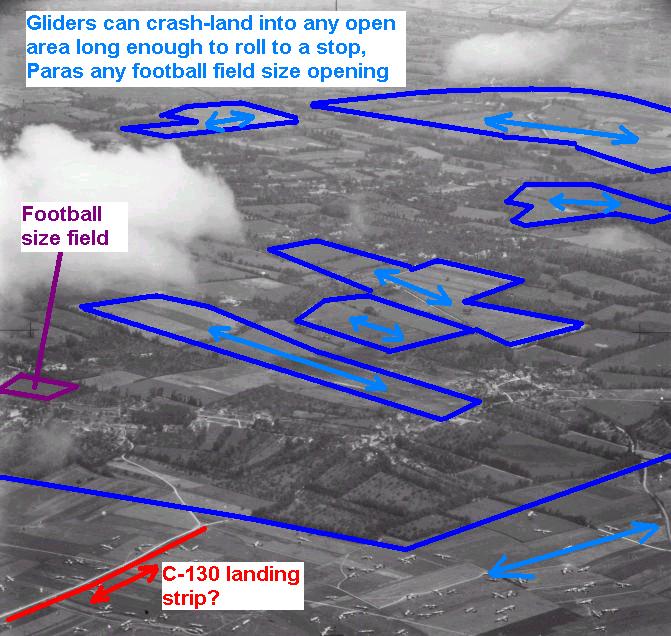
If our bases can shrink to 2, 000 foot runways the security reduction pay-off is a base perimeter of 5 miles for direct fire, 12 miles for mortars and 30 miles for tube artillery such that 1/2 a brigade for close security and 1 brigade for a mortar perimeter or 3 brigades for artillery defense. This is progress towards smaller FOBs that justifies the new twin turboprop-engined C-27J which can airdrop/airland a M113 Gavin light tracked AFV to effect 3D air-mech Sky Cavalry maneuver as Gavin insisted we need. For VTOL air assault operations a reduced-size "Mini-Gavin" can be air-meched by CH-47 Chinook helicopters. This should be the largest plane operated by a small nation's air force since it can deliver real army ground combat power without excessively sized air bases. If we applied ESTOL technologies, the areas to land could be decreased by another half and we'd regain the glider land-anywhere capability we lost when the USAF was born.
The U.S. Army Airborne should adopt a Land-with-Power concept of operation. We should parachute drop M113 Gavin light tanks with the latest armors to counteract land mines and advanced shoot-on-the-move firepower and stealthy electric drive band-tracked 60 mph+ off-road mobility to carry paratroopers. Some with large cannon assault guns and others bulldozer blades and Rhino Snot soil sealant trailers from existing USAF C-130s and C-17s so they need not have to land and we need not have to seize a runway. We then build the runway ourselves just as we were going to do in Holland in 1944 using British flown Hamilcars to carry our bulldozers and airfield combat engineers. This force in light tanks is Gavin's Sky Cavalry and Grange's Air-Mech-Strike Force that has armor protection, superior cross-country mobility, firepower and vital supplies to not just "seize and hold" but can go to where the enemy is and collapse him, an American blitzkrieg that can surprise, encircle and kill/capture Bin Ladens/Noriegas like we did with light tanks in Panama in 1989. In the meantime, we should press the USAF to field a C-17 derivative that can drop 10 ISO container BATTLEBOXes from a few feet over the ground without complicated parachutes in one pass or at higher altitudes glider pods for stand-off coup de main assaults and to create a VTOL assault transport that can deliver one M113 Gavin and a 9-man squad anywhere in the world while being invisible to radar. The American airhead becomes a fortified BATTLEBOX operating base, dispersed, hardened and with self-sufficient solar/wind staying power requiring minimal resupply sorties of fossil fuel and food since it can collect its own water and shoot the enemy's ammunition.
Container Transport Planes: "Cow Pasture" KIWI Pod Aircraft for Speedy, Minimalist Air Delivery
LAPES (Low Altitude Parachute Extraction System) from 5-10 feet has been discontinued from USAF use due to a fatal accident at Sicily Drop Zone on Fort Bragg, North Carolina when a M551 Sheridan light tank on a platform as it rolled off the rear ramp of a C-130 caught both the ground and the edge of the ramp, ripping the plane's tail off. The pilot was actually TOO LOW. The idea of LAPES--using the minimum of parachute materials to get a load to the ground is sound, it just didn't go far enough because it was trying to WORK AROUND A FUSELAGE, subsidizing a pre-existing inefficiency.
LTG Gavin realized this long ago in 1947, in his book Airborne Warfare [www.combatreform.org/airbornewarfare.htm] that the most efficient way to be already loaded and ready-to-fight is to be already be in a KIWI POD, and the fastest way to get this stuff to the ground is not to pull it out break-bulk from inside a fuselage but to DROP THE ENTIRE KIWI POD. If you drop the pod you don't have risks of getting caught up inside the fuselage.
We have Gavin's KIWI pods today--they are called ISO shipping containers. These containers can be made into "BATTLERBOXes" for specific Army missions like being bunkers for troops to live in as well as carry everything the Army needs to fight etc. The early-model Sikorsky CH-54 SkyCrane VTOL helicopter was ahead of its time but required special expensive lightweight pods to conserve its limited 15-ton payload that the Army couldn't afford to buy. The Army today doesn't need costly single-application pods, there are millions of ISOs that can travel by land, sea or air available at less than $5, 000 each. What the Army needs is the USAF to do its damn job and supply a fixed-wing SkyCrane-type transport plane that can deliver 100 tons and drop its BATTLEBOXes with extreme STOL "cow pasture" landing capabilities.
This is a bugaboo because the fighter-bomber jock USAF wants to try to win wars by firepower bombing and doesn't give a damn about helping the Army to win wars by maneuver. The USAF has for over 6 decades refused to supply the Army with a plane that can land on any cow pasture by conveniently only creating runway dependant transports that could parachute airdrop things IF the Army takes the time to rig them with expensive and costly parachutes. This is fine to take a drop zone by assault but afterwards for RESUPPLY the USAF wants a secure and smooth, long 3, 000 foot minimum runway which places Army Paratroopers in a suicidal position of having to first take a heavily-defended airfield or build-one-from-scratch. The latter is do-able but it takes TIME we may not have provided us by a laggard enemy.
All of this complication can be solved by simply creating a C-17 SkyCrane derivative that can carry and DROP 10 x 20-foot BATTLEBOXes from very low altitude as in ZERO---because the plane itself touches only a small air cushion and as it flies forward, ISO containers are dropped in sequence from back to front without ANY special parachutes or platforms.
The BATTLEBOXes might be lined with SKEDCO plastic on the bottom to slide easier along the ground---but that's it. The KIWI Pod C-17 doesn't need a smooth surface for landing gear wheels because its Air Cushion Landing System (ACLS) enables it to land on any roughly flat unprepared surface to then commence BATTLEBOX dropping from such a low actual height that no position-righting parachutes are needed nor any parachutes to pull it out from the fuselage BECAUSE THERE IS NO FUSELAGE! There will not be any LAPES/Sicily Drop Zone type accidents, after the C-17 SkyCrane has dropped its BATTLEBOXes, it takes-off and leaves the assault zone even if its considered "secure" because we don't want the bottleneck of "MOG rate" that occurs when wheel landing gear planes need to after landing taxi back to an upwind take-off position, hogging up the runway. With C-17 SkyCranes there wouldn't be any runways---just an open area with lanes marked on it so multiple C-17s can essentially touch 'n go and drop their BATTLEBOXes.
After the C-17 SkyCrane takes-off from its designated lane, 10 x special M113 Gavins tracked armored fighting vehicles with forklift tines on their front bulldozer blades drive to the 10 x BATTLEBOXes and pick them up like the video game "Pac-Man" and drive them to the collection point, clearing that SkyCrane lane for another pod drop-off sortie. The British figured out they needed tracked armored vehicles to clear supplies off exposed drop and landing zones by glider-landing Bren gun carriers in 1945, and we are long overdue to use this method.
The C-17 SkyCrane-BATTLEBOX would dramatically speed the delivery of supplies to Army forces because there'd be no parachute/shock absorber rigging cost/complication and at 5 tons per BATTLEBOX there'd be plenty of ammo, food, water to grab by simply opening the doors of the ISO containers and getting what you need. The Army just has to grab the entire BATTLEBOX and move it to where it wants it, to include arranging them as walls to create fortified forward operating bases. All that requires for this to occur is for Congress to order and fund Industry/USAF to create and field C-17 SkyCranes to create the EFFICIENCY up-front to deliver containerized supplies without having to work around built-in cargo volume fuselages--current transport aircraft are like old fashioned cargo ships and need to become containerized to be maximally efficient like the container ships the entire world depends on.
Fighter-IN-A-Box: Ground-Mobile Observation/Attack Planes Evade Enemy Targeting and Escort Transport Planes to and from the Drop/Airland Areas
Notice the observation/attack prop planes....capable of high G diving attacks, the heaviest, the A-1 SkyRaider can deliver fighter-bomber ordnance loads of 16, 000 pounds and this capability reduces down to the observation planes capable of only hundreds of pounds or rocket or gun pods. However, the beauty of these "grasshoppers" is that they can operate from 1, 000 feet or less strips and be ground-mobile in ISO container "BATTLEBOXes" if their wings fold or detach like V-2 missiles were in WW2 and impossible to target as Gavin notes. We could have a small grasshopper/large grasshopper team of observation/attack planes or if really hurting for money have just the attack utility plane do it all---observe, attack and transport small teams of men. If AUs can be made to diving attack effectively or have swiveling cannon on their bellies to be stand-off gunships, then they'd be actually OATs--observation/attack transports. Imagine if OATs had tracked or air cushion landing gear---they could ESTOL land nearly anywhere and operate from camouflaged and dug-in BATTLEBOXes ORGANIC to Army ground MANEUVER UNITS--in other words--no static bases needed at all if in a temporary nation-state war situation. Now look at the amazing A-37 Dragonfly capable as a microjet of 500 mph---able to fly slow as well, this jet could shoot down with air-to-air missiles enemy fighters that stray into the Army's low-level air space threatening transport planes if they leak through the USAF's fighter-bombers as commonly occurs. We'd have the low altitude Army Air Forces with a 24/7/365 "maneuver air support" air presence we need to overlap with the medium-to-high altitude USAF that currently has the former mission but doesn't want to do it. A return of the Army Air Force would reduce our land foot print during SNCs and empower Army 2D/3D maneuver during nation-state war, by getting technologies for ESTOL and VTOL on the right track instead of being ignored by the USAF or botched by the USMC with the overly complex flawed V-22.
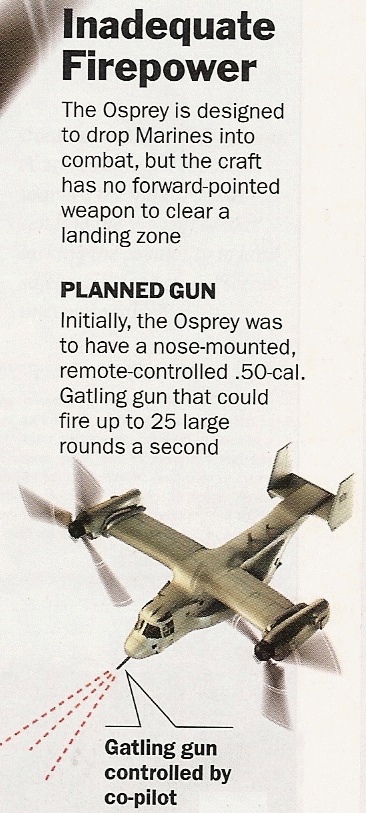
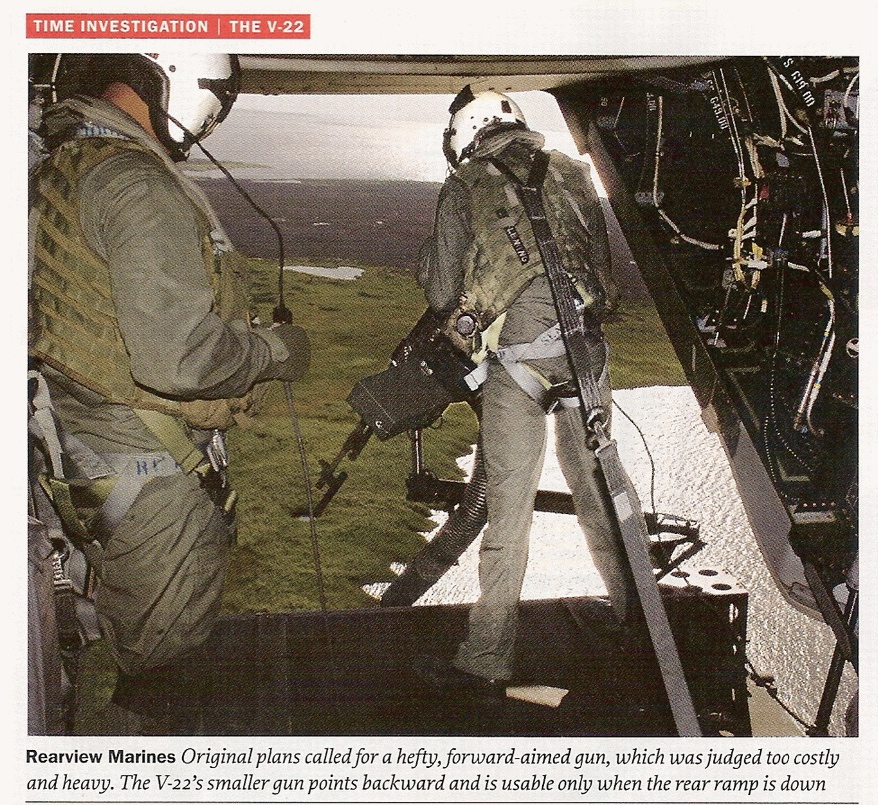
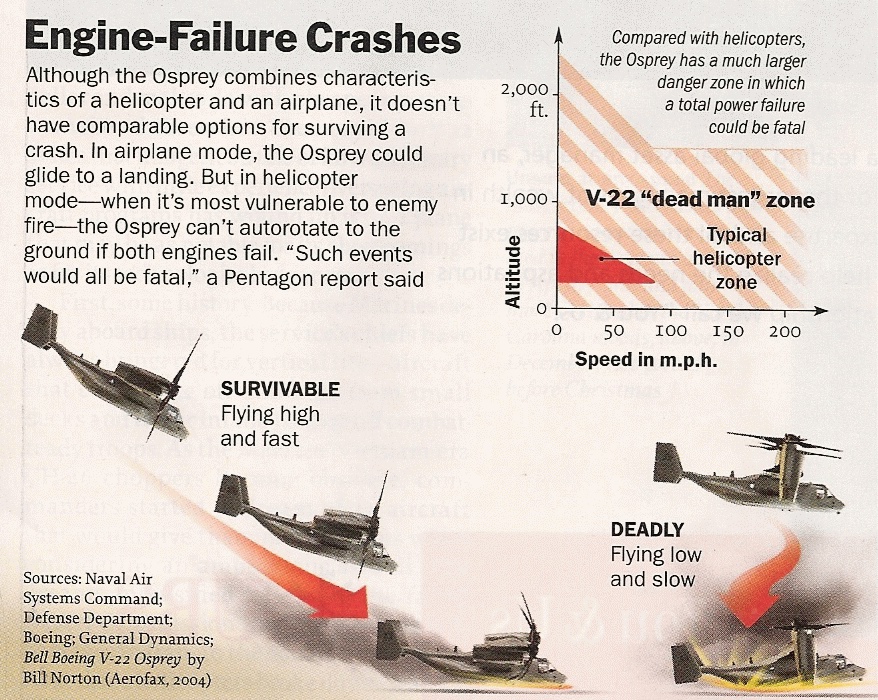
A brief word about the supercarrier Navy/expensive flooding well-deck marines and their lying Midway myth/Iwo Jima re-enactment bullshit sure to pick up on the need to reduce American land presence to try to further their own egorackets. First, there are places in the world where its not cost efficient to fly carrier planes inland. Second, where a watery edge is near a SNC, the grotesquely inefficient supercarrier is a dismal failure as its presence bleeds the taxpayers dry. To make matters worse, the F-18 jets fly too fast to render effective close air support for the Army. If we are to seabase for SNCs, we need affordable container ship aircraft carriers or the large mobile offshore base (MOB) operating useful-to-SNC planes---like the prop-plane SkyRaiders and Corsairs were in Korea operating from smaller fleet and escort carriers. The MOB will again offer real not make-shift runways to operate planes at sea---if we need C-17s to land Army troops ashore the MOB can facilitate this without a bunch of marines dying on a beach to self-validate and seize an air base we didn't need in 1944 to drop atomic bombs on Japan by B-29s and we certainly don't need today. If we want to try to bomb civilians and make their government leaders cry "uncle" this is best done by heavy bombers from land bases or large seaplanes capable of inflicting enough hurt to have effect not handfuls of short-range fighter-bomber "lawn darts" from aircraft carriers.
Either Army Air Forces or Air Commandos---or both
The time has come for Congress to admit the separate service USAF has been a huge mistake and create forces that will prepare for SNCs and act as a Sky Cavalry in nation-state wars. Either the USAF Air Commandos get the job with direct budgetary access to Congress so they don't have to "mother may I" budget in-fight internally with the fighter-bomber egojocks running the USAF brass or the Army gets funding to form its own low altitude Army Air Force with this mission area taken away from the power-hungry, centralizing USAF that doesn't want to do the job. If transport planes transfer to Army ownership/operation then the Army culture of blue collar assholes playing back-stabbing games will have to cease in order to retain the services of the smart adults in the USAF who will not tolerate such childish bullshit. If not, the C-130s and larger transports will remain USAF operated but Congress should mandate their development be driven by Army needs for cow pasture ESTOL operation and end the pampered air base subsidization by deliberate emasculation of transport aircraft landing capabilities. If we don't create sustainable force structures to prevail in limited wars don't complain when we continue to have self-created defeats like Vietnam and Iraq.
General Gavin's most important works are online:
Airborne Warfare (1947)
wwww.combatreform.org/airbornewarfare.htm
Harper's magazine article "Cavalry and I don't Mean Horses" (1954)
www.geocities.com/gavinpetition/cavalryandidontmeanhorses.htm
War and Peace in the Space Age (1958)
www.geocities.com/gavinpetition/warandpeaceinthespaceage.htm
Crisis Now (1968) can be bought used from amazon.com
www.geocities.com/gavinpetition/crisisnow.htm
What would U.S. Army Next Chinooks Do?
The MH-2000Xs would fly directly to where the Airborne troops and Forward Arming and Refueling Point (FAARP) supplies were airdropped by USAF airlifters.
We do believe we need an USAF ATT to eventually replace C-130s when they cannot fly anymore and supplement the C-17s because the "Next Chinook" (MH-2000X) will be used for tactical/operational Air Assault mobility as part of the AIRlandbattle. While the MH-2000X could airdrop Paratroopers out the side jump doors, it couldn't airdrop supplies/light AFVs en masse like a Strategic C-17 Globemaster III or a Tactical C-130 Hercules can to execute General James Gavin's "Sky Cavalry" Airborne warfare. We need a near-VTOL, essentially extreme short-take-off and landing (ESTOL)long-range fixed wing aircraft to execute AIRmechanized warfare for the Airborne as well as a V/ESTOL aircraft for the 101st Air Assault Division. The problem then is what is wrong with the 580+ C-130s now in use?
The C-130 is one of the greatest airplanes ever to fly--only the C-47 can rival it--but only in longevity. It may be the greatest airplane to ever fly. Period. However it could be improved, or it will be replaced since even it will grow old and wear out. We could replace it with a new aircraft starting from scratch like Boeing proposes or improve its design and build new Hercules II models. Here are some of the C-130's problems and what the Next Hercules should solve.
For its 4 engines the Herk only gives us 64 Paratroopers due to its landing gear bulging into the fuselage. Its side jump doors are too narrow which Paratroopers can snag on. The Herk cannot ESTOL land on water or soft soils due to wheels used as the main landing gear. The Herk moves by its props on the ground, creating dust storms. The Herk cannot back up on its own. The Herk can only carry 42,000 pounds of payload and is too narrow a body to carry wider Army vehicles like the medium-weight Bradley IFV and ramp clearance is too low to airdrop them. Material Handling Equipment must be flown in to move supplies offloaded, resulting in more payload loss/complications. The Herk is not radar invisible.
Thus, in our opinion the Next Hercules should be:
1. Able to lift/airdrop 50 tons--a single High Technology enhanced Bradley IFV or 3 x M113A3 Gavin AFVs so U.S. Army Airborne forces can be airdropped with complete secondary mobility on the ground via tracked armored fighting vehicles (AFVs) for offensive missions not just "seize and hold" defensive airfield seizures..
2. Be "stealthy" low-observable in radar and FLIR so it can execute Airborne operations without being detected by the enemy at either high/medium altitudes or terrain contour low-level flight profiles under 250 feet.
3. Able to land anywhere--including water--uneven terrains---under 1,000 feet using tracked landing gear and/or air cushions to facilitate smaller forward operating bases (FOBs) requiring less combat power loss having to defend the air base from enemy sapper, small arms fire, mortar, artillery and MANPADS attacks during nation-state wars (NSWs) and less irritating presence to the civil populace during sub-national conflicts (SNCs).
4. Powered ground wheels/tracks for dust-free movement in the assault zone and backing up.
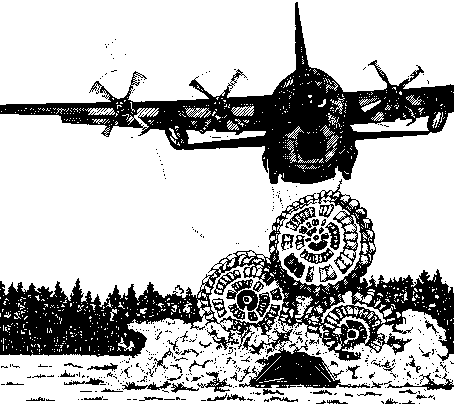

5. Able to airdrop and load/offload U.S. Army PLS flat racks as Colonel Shine suggested in his superb article and/or up to 4 x ISO container "BATTLEBOXes". Army FMTV and HEMMT PLS variant trucks can pick up these PLS flat racks and move them after the Next Hercules offloads them. This eliminates re-packing and recovering fragile 463L type pallets. Special PLS flat racks should be developed that can be airdropped from the ATT and existing USAF airlift aircraft.
6. Have a rear ramp that is adjustable so cargo can slide directly from off/onto the back of Army vehicles etc. without needing MHE/forklifts
7. 400+ mph/indefinite range via air-to-air refuelling
8. Provision for JATO rockets for V/TOL take-offs when required
If we made the payload 35 tons, we believe a "L" model Hercules could be the Next ATT by re-designing the fuselage primarily into a wider, "stealthy" form. But clearly, a brand-new aircraft would insure we obtained all the revolutionary features needed, we simply may not have the money to ever see it fielded...troops need real not power point airlift.
The "Next Hercules" would be automatically a SOF insertion/extraction platform (Combat Talon IV) by its land anywhere capability to include as a seaplane---NAVSPECWAR and CSAR missions. It would be able to act as a tanker aircraft and operate from unimproved areas away from runways/airfields likely to be targeted by the enemy. Thus, the "Next Hercules would also be the "Next Combat Talon" and the "Next Tanker" and a host of special mission variants.
What about a Burnelli type lifting body for the ATT?
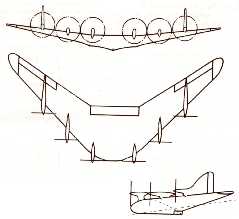
The Vincent Burnelli lifting body design could be applied to a seaplane....British designer H. Roxbee Cox proposed this 6-engined flying wing seaplane just before WWII...with an unlimited take-off run and the 100% lift efficiency of a flying wing, the SEAPLANE deserves another examination with modern technologies....

Also imagine if a Burnelli-type Extremely Short take-Off and Landing (ESTOL) aircraft had air cushion landing gear?
[Artwork courtesy of Mr. Ernest Zavala who is writing a book on the history of Burnelli aircraft]
It would become a defacto seaplane, able to land in oceans, rivers and lakes...and it would be able to land almost anywhere on land without actually needing hard surfaces for wheels to roll on....the russians have already put into production such a combination airplane/hovercraft even though it was Bel Aircraft in the 1960s/70s that first conceived of flying prototyle aircraft with this revolutionary landing/take-off system.....who needs costly, unsafe V/TOL hybrids if you can land almost anywhere in an extremely short distance irrespective of the terrain type?
Imagine setting up our troops anywhere around the world in less than 12 hours after leaving their U.S. home base and deploying them to surround the enemy in all terrain? Ride on a cushion of air and set them down without having to "daisy" bomb an area for landing an aircraft. Talk about them not knowing where we will strike!
For more info on the fascinating Burnelli type aircraft and how its THE solution to future fixed wing air transport:
FEEDBACK!
